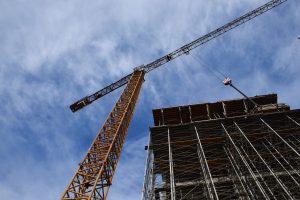Tower crane professionals from across British Columbia came together recently for the Tower Crane Industry Safety Conference. It was the first such conference held in B.C. since 2009.
The approximately 150 attendees at the March conference in Richmond included tower crane owners, suppliers, engineers and technicians.
The conference was part of the implementation of WorkSafeBC’s (WSBC) 2018-2020 Crane Industry Initiative, which promotes the safe erection, operation, maintenance and inspection of tower cranes.

According to WSBC, the purpose of the agency’s tower crane strategy is “to identify and eliminate specific tower crane hazards and unsafe work practices that have the potential to cause serious injury, death or catastrophic equipment failure.”
Tower crane operation in B.C. is not without its occasional mishaps.
In 2017-18, a dozen tower crane incidents were reported.
The majority were caused by crane and hoist equipment failures; contact with overhead conductors, tower cranes and concrete pumps; and workers being struck by falling loads or by rigging and other objects.
“Because the last tower crane conference took place almost 10 years ago, WorkSafe and the B.C. crane industry realized it was time to get together again,” said Al Johnson, WSBC’s vice-president of prevention services.
Johnson says tower crane operators in B.C. face many challenges.
“There are construction cranes everywhere you look in the Lower Mainland,” he said.
“Buildings are taller, cranes are taller and many of them are operating on narrower plots of land.”
Conference sessions dealt with different aspects of tower crane safety. For example, OptiCrane Inc. is a Maple Ridge, B.C. company that distributes range-limiting and anti-collision devices for tower cranes.
The systems allow operators to protect public areas and electrical conductors, says OptiCrane founder and operator Paul Roussel.
“They also monitor each crane’s position in real time and warn the operators through visual and audible warnings, as well as slow and stop the cranes as per programmed parameters,” said Roussel.
OptiCrane is also a distributor of a line of industrial cameras.
“In addition to eliminating blind lifts, by providing operators with a straight-down view of the load from any crane, site progress can be monitored wirelessly through the web,” he said.
Roussel says tower crane safety technology has room to grow in Canada.
“Several high-level developers have adopted the technology and are using it,” he said.
“But the industry is not yet at the European level, where most cranes are equipped with these systems.”
Roussel says the main factor that is limiting the adoption of safety technology is that they are not yet mandatory.
“Some jurisdictions still allow the use of written safe-work procedures, despite engineered devices being readily available,” he said.
Cathy Lange described the BC Construction Safety Alliance’s (BCCSA) Technical High Angle Rope Rescue Program (THARRP).
THARRP is a train-the-trainer program that helps fire departments meet the requirements for technical high-angle rope rescue.
“THARRP prepares fire department personnel in technical rescue procedures for workers at height, such as tower crane operators, who are in distress,” said Lange, who is chairwoman of BCCSA’s THARRP Committee.
Since 2013, there have been 47 crane rescues in B.C., says Lange.
“Most of the people who have needed to be rescued are members of the public,” she said.
All of the 34 paid fire-fighting departments in B.C. (not including the many volunteer fire departments) have had THARRP training to national standards since 1991, Lange says.
A program development officer with the Industry Training Authority (ITA) updated conference attendees on the new requirements of the Red Seal program.
In December, 2017, ITA launched a Red Seal program for tower crane operators.
Before the change, an ITA Certificate of Qualification was available, but without Red Seal endorsement.
“The Red Seal endorsement is an indication that a tradesperson has met the national standard for the trade,” said Colleen Rogan, manager of ITA program standards.
“Provincially, we work closely with BC Crane Safety to implement standards that meet national Red Seal requirements and also serve the needs of BC Crane Safety.”
WorkSafeBC’s Al Johnson called the conference “a great success.”
“We expected between 50 and 60 people, but more than 150 people attended,” he said.
He says the conference was so successful, in fact, that there are already plans to hold a similar event in 2019.
“It will probably take place some time in the first quarter of next year,” he said.
“It’s a valuable opportunity for WorkSafe and the crane industry to get together, touch base and discuss what’s new.”











Recent Comments
comments for this post are closed